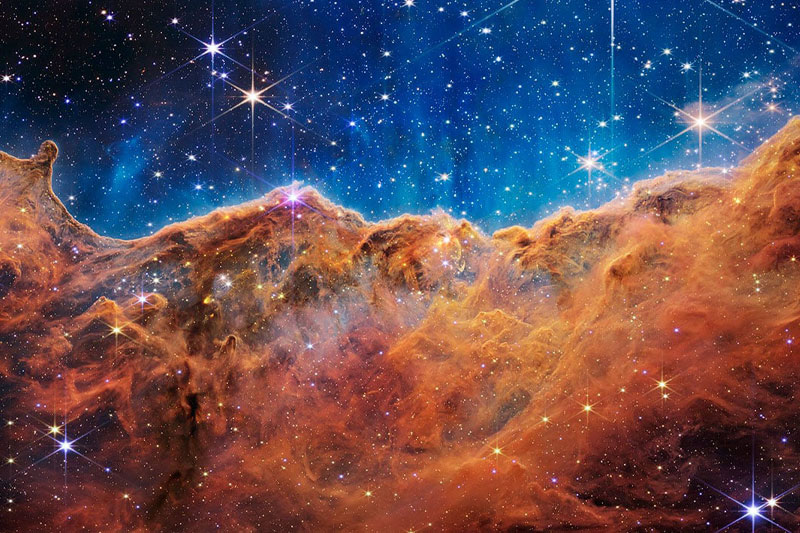
To enable the spirits to enter into this process of growing their capacity for God Consciousness [See What is “Spirit”?], God breathes forth His own Self as the Power from which is manifested all the realms of relative existence, from the most subtle worlds of perfected and nearly-perfected beings to the most objective worlds of atomic matter.
They can then enter into relative existence by taking on coverings, or “bodies,” of varying grades and patterns of vibratory energies. They descend into this material world and begin working their way up the ladder of ever-evolving forms.
Beginning with forms whose scope of consciousness is vastly less than theirs, they work their way upward, entering into higher and higher levels of awareness until they can surpass their original breadth of consciousness and begin to partake of a life of awareness much beyond their own. This then culminates in their developing the ability to share in the Divine Consciousness Itself.
The Seven Worlds
There are seven worlds (lokas) or main divisions of relative existence. These Seven Lokas or Seven Worlds are the seven rungs of the evolutionary ladder. They correspond to the seven levels of consciousness that determine which of the worlds the individual spirit incarnates in. Keeping in mind that “world” in this list does not mean a planet, but a great division that includes within it many levels of existence–many planes of consciousness–here is a list of the seven worlds:
- Bhur Loka, where the dominant consciousness is that of matter.
- Bhuva Loka, where the dominant consciousness is that of feeling–emotion, instinct, and lower intuition.
- Swar Loka, where the dominant consciousness is that of sensory experience.
- Maha Loka, where the dominant consciousness is that of thought and reflective perception.
- Jnana Loka, where the dominant consciousness is that of fundamental causation and spiritual intuition.
- Tapa Loka, where the dominant consciousness is that of mastery of all the lesser elements and levels.
- Satya Loka, where the dominant consciousness is that of spirit-consciousness itself.
Bhur Loka is purely material; Bhuva and Swar Lokas are astral; Maha Loka is a mixture of astral and causal; Jnana and Tapa Lokas are completely causal; and Satya Loka is a mixture of extremely subtle causal and pure consciousness.
Incarnating spirits move upward and downward in the three lower worlds of Bhur, Bhuva, and Swar, but once they attain the level of Maha Loka they are never reborn in the three lower worlds unless they will to do so. Spirits may move between the two worlds of Maha and Jnana, but once they reach Tapa Loka they remain there until they evolve into Satya Loka which is the world of the perfectly liberated spirits and the spirits that have evolved beyond Tapa Loka and are so close to liberation that they can arise to such a rarefied spiritual atmosphere as Satya Loka. Those liberated spirits who return to lower worlds for the benefit of others do so as avatars, incarnations of God.
Life in the Astral Lokas (Regions)
In the intervals between embodiments the spirit spends time in the astral regions where awakening and growth also take place. (This is best explained in the forty-third chapter of Autobiography of a Yogi by Paramhansa Yogananda.) Upward and upward they evolve until their capacity for awareness is developed to such a perfect state that they can experience and participate in God’s all-embracing Consciousness, thenceforth to live in His infinity.
As Shakespeare wrote, “all the world’s a stage” with the individual spirits wearing their costumes and playing their parts. Just as actors begin with small parts and progress to bigger roles by demonstrating their skill in those smaller parts, so also do the spirits advance to higher and more complex forms of existence and consciousness, at last returning home to God. The Sufi poet, Rumi, wrote:
A stone I died and rose again a plant.
A plant I died and rose an animal;
I died an animal and was born a man.
Why should I fear? What have I lost by death?As man, death sweeps me from this world of men
That I may wear an angel’s wings in heaven;
Yet e’en as angel may I not abide,
For nought abideth save the face of God.Thus o’er the angels’ world I wing my way
Onwards and upwards, unto boundless lights;
Then let me be as nought, for in my heart
Rings as a harp-song that we must return to Him.
Oliver Wendell Holmes, one of many great Americans whose belief in reincarnation is overlooked, wrote in his poem, The Chambered Nautilus:
Build thee more stately mansions, O my soul!
As the swift seasons roll!
Leave thy low-vaulted past!
Let each new temple, nobler than the last,
Shut thee from heaven with a dome more vast,
Till thou at length art free,
Leaving thine outgrown shell by life’s unresting sea!
That is the purpose of creation and our place in it.
Random Gems:
- A Conversation Between Yogananda and “M” on the Cosmic Mother
- 5 Reasons for the Smile of Krishna
- How to Burn Our Karmic Seeds







